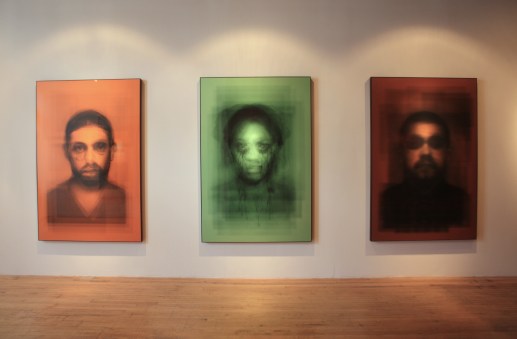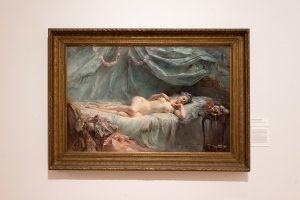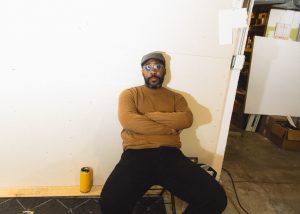It is not everyday that we are confronted by work that stops us in our tracks, works at our psyche and leaves us wanting more. When I first laid eyes on the work of Argentinian-born artist Marcelo Grosman, I couldn’t help but wonder who the artist was and who were the people in these spellbinding and unsettling images. Guilty!, the most recent show of Grosman’s work at The Mission Projects, brought together Chicago-specific works that used the open image source provided by the Illinois Department of Corrections Inmate Database to create a show that was not only visually arresting, but act as a window into the disturbing truths that weave themselves into our local and global systems of control. During his visit to Chicago in late September for Expo Chicago, I got the chance to speak with Marcelo and The Mission Projects director, Natalia Ferreyra, about his constantly evolving relationship with photography, process and purity in portraiture, and his desire to reinsert the aura back into the duplicated image.

Tempestt Hazel: Before we get into the work of Guilty!, I would like to start by asking you a bit about your background and the path that led you from Argentina to here, showing at The Mission.
Marcelo Grosman: I am a photographer first. I also studied architecture and political science. I’ve been involved in the art scene of Buenos Aires for many years. Besides having a career as an artist, I’ve also worked on some of the art festivals. All my life I have been involved in the art scene there. In the past few years I’ve abandoned classic photography.
TH: So, you once did more traditional photography.
Natalia Ferreyra: Like portraiture.
MG: Yes. And I’ve started to incorporate other art forms like installation.
TH: It’s not uncommon for photographers to branch out into other mediums outside of traditional photography. What caused your move into experimenting in other mediums?
MG: I think the most important things in photography have already been made.
TH: You don’t think you have anything new to add to its history? To the conversation?
MG: Hmm…maybe. Photography is an industrial medium. And when the industry moves on, we must move with it.
TH: I completely agree with you.
MG: That’s what’s important. The traditional photography… [further explanation in Spanish]
NF: He’s saying that the procedures of photography were produced by its own industry. His point is, photography was essential when many parts of the world were industrializing. Now, we’ve moved forward in that, especially in technology, we must move with the times and start incorporating the technology of the time.
TH: And this work, the work in Guilty!, is a perfect example of that. And now you’ve landed here in Chicago. What got you here?
MG: Natalia! [laugh] I think it’s natural in an artist’s career to move outside of the country. Natalia and Sebastian contacted me in Buenos Aires, they liked the work and they brought me here.
TH: How is Chicago treating you?
MG: Fantastic! This is my first time being here. It’s a great city–amazing.
TH: What I find so interesting is that your first introduction to Chicago was through this series. You have been looking at a dark, underbelly of the city. So, what was your perception before coming here through the work that you were doing in Guilty!?
MG: A few days ago I was in the Art Institute, looking at the collection of photography. In the collection, the first photo in the installation of work was this…
[shows a photo]
Alphonse Bertillon was one of my references for this work. He is a French doctor from the 19th century who invented the system of anthropomorphic photography to classify people. This was in the 1880s. The first place in the United States to adopt this system was Chicago.

MG: Yes. So, in general, my work is about the institutions of control. I come from a country where a large part of our history has been a dictatorship and about the control of the citizens. [In my work] I want to explore these systems of control–the military, the family.
TH: The family? That’s a great sequence–first you say military and I automatically see the control, then you say family and it was a bit unexpected. But it’s true.
MG: Yes! [explanation in Spanish]
NF: He’s talking about the functions of family and how traditionally they move from generation to generation and administer their property because everything goes through your family, especially in South America.
TH: I understand–so that aspect of family control?
MG: Yes.
TH: You started this body of work in Argentina, using the population there. Now, you’ve used a segment of the US population in this recent iteration of the series. What are some of the parallels, if any, that you found between the subjects based on location? And were any of them shocking to you?
MG: I think the institutions of control are everywhere–universal. It’s not necessarily a local thing. And in this sense, I saw [little] difference. I think that maybe everywhere is a little specific, but in general [this is] the way the occident or the different parts of the world in the 21st century are organized. In this sense, I think it’s no different in Argentina than it is in the United States. In December, I am going to Tunisia to make this work. I will be using the mug shots of Tunisian people to make a series like this, but localized.
TH: Since you can move it from place to place, city to city, country to country, does this series function as a way to reveal similarities and parallels between different people in different places? In the other work I’ve seen like this, I can’t really tell whether the composite photos are from Argentinians or Chicagoans. I would have to guess or try to pinpoint different cues, but even then I think it would be mostly guessing.
MG: Yes, but we are all people. In reality, race doesn’t exist. The frontiers are arbitrary also. We are all people and that’s what is most important. I don’t make local art because I believe little in specificity.

TH: The work is so compelling and beautiful, but there is so much trauma in it. How do you go about picking those subjects? Do you focus on people who show that desperation, that vulnerability?
MG: These photos were taken from the state. They were made when these people were arrested. But some of these portraits are some of the best photos I’ve ever seen. In the typical relationship between photographer and subject [when making a portrait], there is [an element] of seduction. But in the case of a mug shot, the relationship is transparent. It’s absolutamente transparente… there’s no relationship at all, which makes the subject very transparent–there’s clarity in that moment.
NF: What he’s saying is that they basically give themselves to the photographer for the mugshot and you can see through them rather than in traditional portraits there’s an element of play between the subject and the photographer. It’s very raw–you can’t hide because there’s no relationship. So, the photograph captures that person at one of their purest moments.
TH: I wonder…there are other mugshots that I’ve seen where it’s almost a challenge or not so vulnerable.
MG: It is a systematic process and they’re not inviting you to take the photograph. You get your photo taken, then you move on–it’s quick, it’s immediate. It really captures them in that immediate process. It’s like a factory.
TH: What you’ve compiled from these photographs seems to be the capturing of that shift in control. Having the freedom to do what you want and then suddenly not.
MG: Yes, it’s that moment when [people realize] “I no longer have control of me. The state has control of me.” And in this situation it’s not true that they must challenge the situation. At that point, the state has control of your life and you’re processed into the system.
NF: What he was saying too is that what he finds as a universal theme is that these institutions and systems work as they do in Chicago, Buenos Aires and Tunisia–it’s a system. And that’s what he is really investigating.
[Going back to] one of the questions you had about the parallels that he found–when I spoke to Marcelo [a while back] one of the parallels [he mentioned] is that in Buenos Aires, you will find that the people who are brought into the system are minority groups, like Bolivians.
MG: Yes! One of the supreme court judges who is one of the most prestigious criminal lawyers in the country made the archetype of the kind of inmates in Argentina as morocho…
NF: Morocho is a word we use meaning dark-skinned…
MG: …the morocho of Gran Buenos Aires, which is the suburbs of Buenos Aires. In Latin America the suburbs are not like they are here.
NF: It’s the ghettos. The ghettos surround the city. The city is in the middle then the ghettos build up around the city–like the favelas in Brazil.

MG: The stereotype came to be someone with dark skin. I read a study from the [Cook County Sheriff] and the stereotype of an inmate in Chicago is a Black man of 32 years. This [pointing to one of the works in the show], is the stereotype. Here it’s that. In Argentina it’s morocho. In Europe it’s immigrants…everywhere it’s a minority or a stereotype. What minority is not important–it’s the fact that it’s a minority.
TH: It’s the relationship that a certain group has with the dominating population…
MG: Yes.
TH: I’m intrigued by your process. Can you go through your process? For me, I can’t settle my eye on the images which makes it hard to look away. I guess that reinforces the source and the story behind these images, which is unsettling. How do you build up these images to have such movement?
MG: Walter Benjamin wrote about the aura and the loss of the aura in photography because of reproduction. I try to recover this aura. It’s important not to just look at the reproduction, but to experience these photographs first. After that, I work in the same way that the anthropomorphic system was built. Statistical construction. Division by sex, gender, ages, ethnic group–that is how I classify the mugshots. After that, I look for themes–the tears, the grills…and after that I work with twenty, thirty or forty photographs.
TH: What you’re saying is that they are composites of many individuals…
MG: Yes–these people don’t exist.
NF: They’re all, but they’re none.
MG: These [composites] make up the archetype or stereotype. Like this one is called Male, 31 to 55 years. Or this one, Male 25 to 30 years. Because the state uses these classifications.
NF: It’s very statistical, which again reinforces the rhetoric of stereotypes.
TH: And that type of classification allows for a person working for these systems or even for you as an artist to keep a certain about of distance from the subjects.
MG: The title of the work, for me, is part of the work. The title was built in a political sense in terms of a state structure. They aren’t innocent titles.
TH: Have you had anyone from the correctional system in Chicago see the work?
NF: We sent out the invitations…
TH: I would be interested in hearing their reaction to the work because it points a finger at them.
NF: The reason we decided to have Marcelo show at The Mission is because he does something that is very important to us as a gallery, which is the marriage of the aesthetics, what you see here, and a very deeply intellectual and academic purpose behind it. As a gallery it is important to us to have artists who are doing that kind of production. This is important work–not only as a work of art but also as a dialogue. What we’re moving to be more vocal about is asking how local institutions are taking part in that dialogue. That’s something that over time I would like to push the boundaries of and challenge the institutions here in Chicago with the work and the artists that we work with. To open those lines of communication that is not only part of the city but also international.
TH: I think that international piece is really important–to make connections between the local and global. I’m guilty of thinking very locally sometimes. I become weighted and rooted in Chicago and forget about the larger picture. It’s work like this that allows us to remember how much we all have in common with people we’ve never met who are on the complete opposite side of the world. I appreciate you taking on the challenge of challenging people to take on this work.
NF: These pieces are not only aesthetically beautiful, but they could also be educational on many levels. It really says something about our city and some of the cultural and social issues we have here in Chicago. These are the works and artists we strive to work with and bring here.

TH: One of the first times I saw one of your pieces, Marcelo, was in Sebastian’s private collection. And what made it stand out in my mind was the striking scale of these images. Can you talk a bit about how scale relates to the concept of the work?
MG: The change in the structure of the production of photography and what is available in the industry is very important. I make these big because I can. It’s available. After that, the scale makes it more human. The relation of the body to the piece…
NF: We laid out the exhibition to be very interactive. Each of the pieces is at eye level with you. They are all made that way to interact with the viewer. Then, when the sun goes down the pieces start to interact with one another. You begin to see the reflections of pieces in one another from across the room.
MG: I enjoy working on these pieces, and I also enjoy installing the pieces. This is important to me. Each piece is installed specifically for the space [in which they are exhibited]. I work with the space.
NF: So the works in this show are size-specific for the gallery.
MG: Eight of the ten were specifically made for Chicago. In aesthetic history people associate beauty with kindness….and we must shake that up. [Further explanation in Spanish]
NF: He’s saying, how would it look if malice or something that is ‘wrong’ or ‘bad’ was beautiful at the same time? He’s playing with those two contradictions or two extremes. When you look at the work, the color and the way they are made, they are beautiful pieces. But they are very raw. And they are showcasing the stereotype of someone who isn’t understood as being good.
MG: I like to make work that is contradictory. That for me is a real art piece.
NF: I think your new body of work does that same thing. He’s starting to work on a new body of work that is beautiful when you see it [from a distance] but when you get closer and start looking at it and thinking about it you realize it’s something that is no longer the beauty that you thought you originally encountered.
TH: Is it falling in the same vein of this work, or is it different?
MG: They’re family, but a generation apart. They’re extended family. It’s about physical violence but made in a way that looks like a dance.

TH: I may be revealing the romantic in me by saying this, but it’s that kind of contradiction that really draws me to certain work because it reveals something to me about myself. I have to straddle that line or try to figure out where my own perceptions, understandings and opinions fit in when looking at this work. Seeing it as beautiful, recognizing the trauma, knowing who these people are but not knowing who these people are and what I’m supposed to understand them as…I appreciate the challenge of having to reconcile my own thoughts through this work.
NF: At the end of the day it’s about encountering work that will make you think and that is going to make you challenge what you’re looking at. And, again, initiating a dialogue.
TH: I must ask, in all of this, how many mugshots do you think you’ve flipped through?
MG: Thousands.
TH: Have any of them left you speechless?
MG: Yes–so many of them are some of the most beautiful I’ve ever seen. I have empathy for these people.
TH: Although I can deduce where it came from, I want to ask about the title of the show. What does it mean for you?
MG: In Buenos Aires, this word is associated with a circumstantial issue of security–the people, robberies. I tried to separate the title from that. It could have been in any language. But I wanted to dislocate it and take it out of its local context–so, I used English. At one point I was going to call it ‘Guilty’ in Spanish. Here, we say ‘innocent until proven guilty.’ These are all mugshots, and mugshots aren’t taken when you’re guilty. They’re taking when it is presumed that you are guilty–before you are sentenced.
NF: It’s ironic because once that photo is taken of you, you are stereotyped and socially understood as guilty.
MG: The most important thing about this work is that on one hand it is about these people and on the other hand, it is a critique of the photographic medium. The photographic medium doesn’t reflect reality, it constructs reality. This is part of the work–the construction of our reality by the media.
Guilty is on view at The Mission, located at 1431 West Chicago Avenue, until October 27, 2012. Learn more about the exhibition by visiting The Mission’s website at themissionprojects.com.
All images are courtesy of The Mission Projects.






